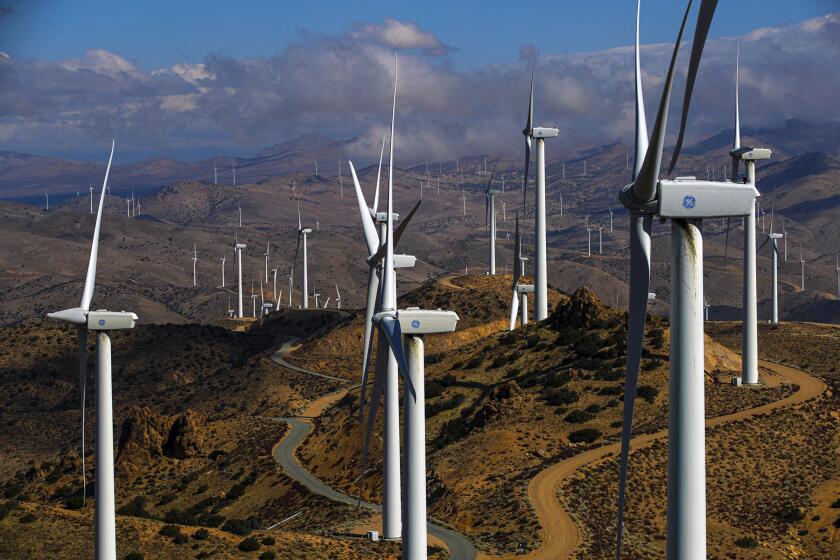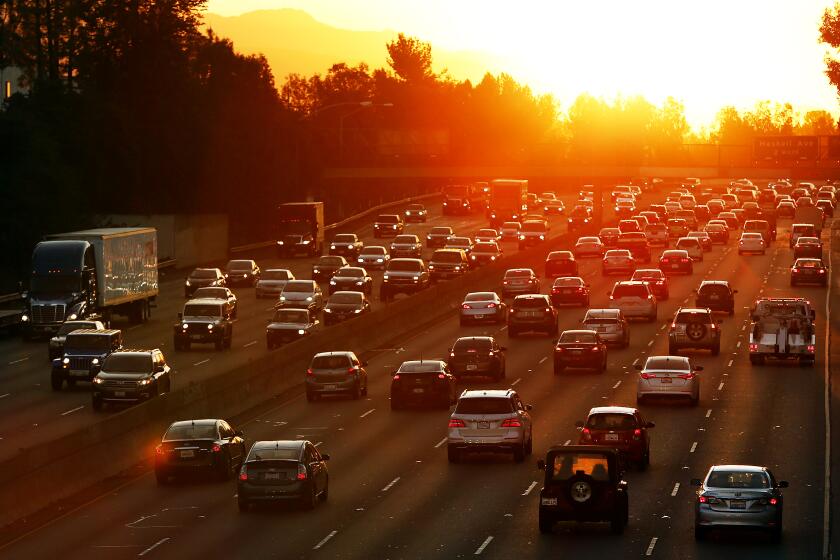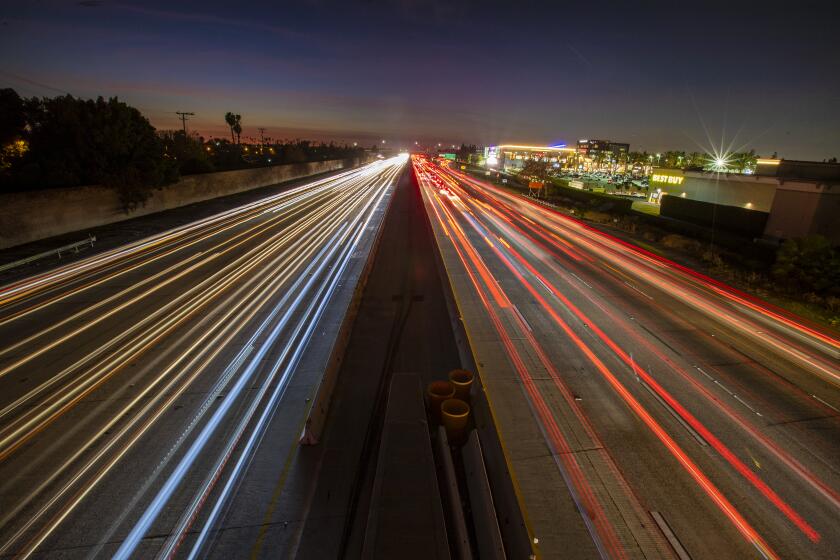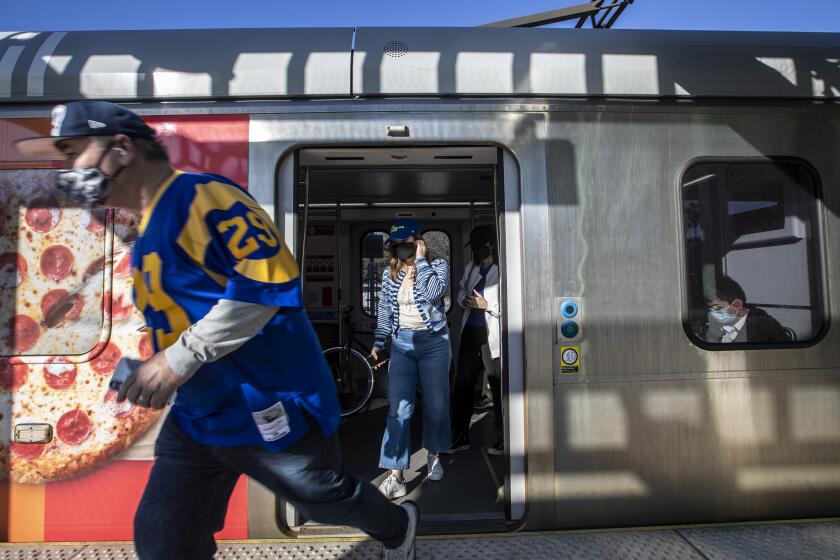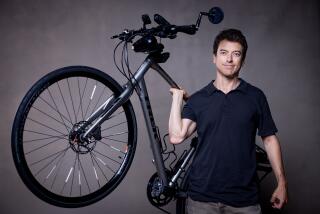The freeway was born in L.A. But it might not always be free to drive on
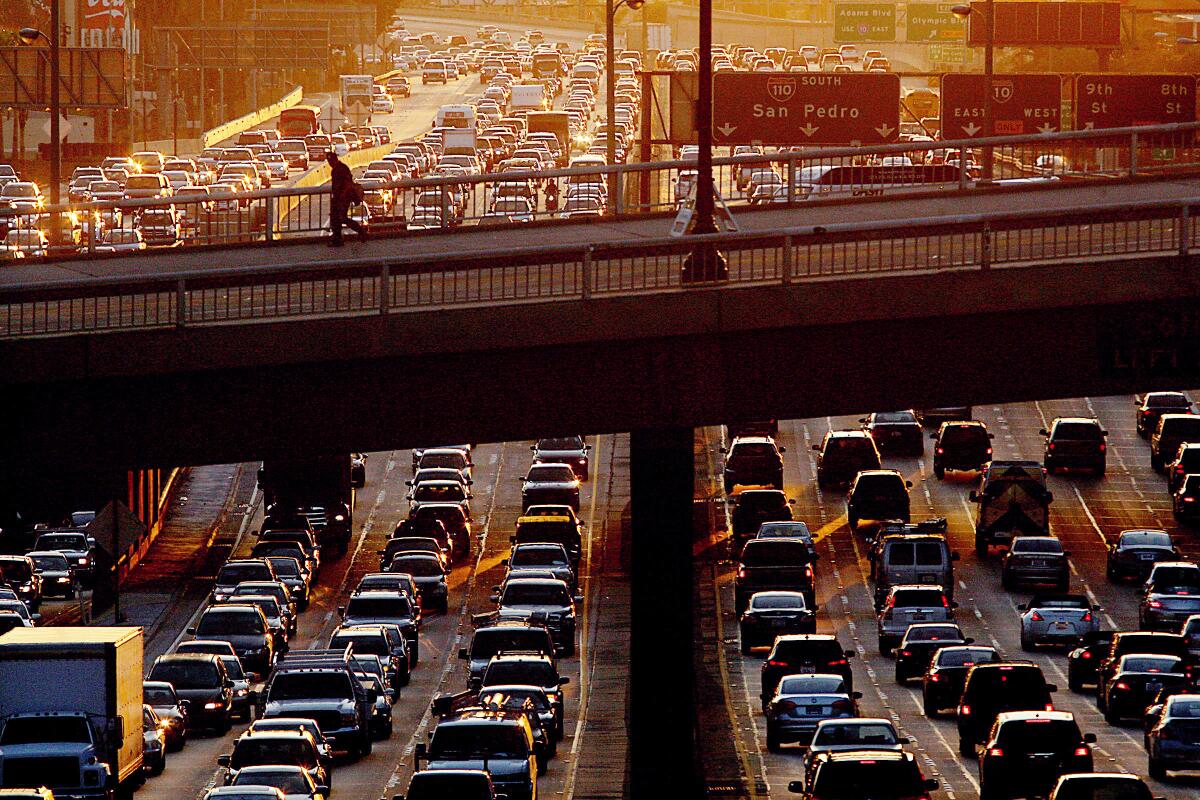
Merging onto the Santa Monica Freeway at rush hour or along the infamously choked Sepulveda Pass could carry a price for Angelenos — and a promise.
The Los Angeles County Metropolitan Transportation Authority is expected by the summer to release a long-awaited study that will offer a blueprint for a congestion pricing scheme similar to ones in cities such as London, Stockholm and Singapore, where commuters pay to drive in city centers.
The transit agency has zeroed in on three locations for a possible test program: a nearly 16-mile stretch of the 10 Freeway between downtown and Santa Monica, arterial streets and freeways around downtown and the canyon streets and freeways that connect the San Fernando Valley to the L.A. Basin.
Details of the plan — including pricing, the technology and projected revenue — are still being ironed out. But Mark Vallianatos, who is overseeing the feasibility study at Metro, expects the agency will make its findings public in the coming months, with a vote by the board early next year. The pilot project will include subsidies for low-income drivers and carpoolers and funding that would create alternatives to driving solo.
Years in the works, the plan promises cleaner air, smoother rides and more funds to the agency’s coffers in the future. Studies show it could reduce harmful air pollution and greenhouse gas emissions by pushing more commuters to use public transit, while making roads less hellish for those who pay to use them.
“It’s really about making it easier for those who drive to get where they need to go faster, more reliably,” Vallianatos said.
The California Air Resources Board has released its long-awaited scoping plan, a roadmap for the state to drastically cut its carbon emissions.
The pilot program is part of a larger push among major cities to rethink how to deal with traffic that eats up commuters’ lives and pollutes communities as vehicles creep along. California has been quietly setting the stage for road pricing for years.
Caltrans recently hired someone to oversee roadway pricing on its routes. And the Biden administration has set aside millions to fund a pilot program that charges drivers by the mile. The Federal Highway Administration is preparing to seek nominations for an advisory committee that will help establish the parameters for pilot programs.
Still, it will be a difficult sell for drivers accustomed to free roads and for the politicians who represent them. Proposals to cordon off certain parts of the region to paying drivers or charging people for miles driven have provoked political backlashes elsewhere.
Earlier this month, the Federal Highway Administration gave tentative approval to New York’s first-in-the-nation congestion road pricing plan, intended to fill financial gaps. Transit officials there say the technology to run a program could be up by next year, but opponents have threatened to thwart efforts.
In San Diego, a plan to charge users per mile traveled was killed amid political opposition. And in the Bay Area, transit planners iced a downtown congestion plan after the pandemic emptied out the city center, although another study to charge for using major Bay Area freeways is underway.
But perhaps nowhere in the United States would it be as consequential as in car-centric Los Angeles, the land of the SigAlert and the birthplace of the freeway, where commute times, traffic collisions and gas prices play large in the daily consciousness. The region sprawled, but no matter how much roadway it built, the snarl of traffic caught up with it at every turn.
In Los Angeles, people spend an average of 95 hours a year stuck in traffic, according to Inrix, a transportation analytics firm. That’s not as bad as some more urbanized cities such as Chicago, where people lose 155 hours a year, but the slog is still acutely felt.
Along the 5 Freeway southeast of downtown — ranked the second most congested corridor in the nation, commuters regularly traveling it lose 127 hours — or more than five days of their life — every year in traffic. On the 405 Freeway in the Sepulveda Pass, drivers motor along at 16 mph during the evening rush hour, an even slower pace than before the pandemic.
On an average day, more than a quarter of a million motorists drive through the Sepulveda Pass, according to data from the California Department of Transportation.
Traffic has long been a headache in Southern California — but there are ways to cut down on the congestion.
Still, skepticism about the pricing plan is high. Unlike the express toll lanes of the 110, 10 and 91 freeways, the whole roadway would be included in the model under consideration.
“We’re not talking ‘Lexus lanes’ here. We’re talking congestion pricing,” said Stuart Waldman, president of the Valley Industry Commerce Assn. “Politically, I just don’t see how this happens. And, I don’t see it moving forward.”
He said pricing roads in and out of the San Fernando Valley, which his group represents, would divert traffic to neighborhoods and could put some businesses at a disadvantage.
Within Metro, the idea was deemed so politically explosive that agency Chief Executive Stephanie Wiggins asked staffers to hold findings days before public meetings were set to be scheduled early last year. She didn’t want the plans out during the election season, when the issue would have become a political hot potato as seats were up for grabs on the City Council and the Board of Supervisors and for mayor, according to those close to the project at the time, who asked not to be named.
The project team, they said, had already been thinking about how to generate support for such a sensitive issue. The first versions were quietly shared with interest groups including those in downtown, who worried that it could make driving to the city’s core less attractive. Others feared it could further hurt those making the least in a region already beset by high housing prices.
Early modeling didn’t include subsidies. It merely gave a glimpse of how lucrative such a program could be, generating an estimated $400,000 to $2.5 million daily in gross revenue.
So planners went back to the table, tweaking their first proposals and adding further scenarios to show what a system that exempts the neediest would look like.
The aim is to change commuter behavior with the charges while providing transit alternatives.
“There is no other way to reduce congestion. So you can do something like this or basically you can just live with congestion,” said Michael Manville, an associate professor of urban planning at the UCLA Luskin School of Public Affairs who has studied congestion pricing.
Sign up for This Evening's Big Stories
Catch up on the day with the 7 biggest L.A. Times stories in your inbox every weekday evening.
You may occasionally receive promotional content from the Los Angeles Times.
He likens the concrete and asphalt streets to a public utility that is in high demand and short supply. Yet, unlike water, gas and electricity, people aren’t accustomed to paying for it.
“If the price of heat goes up, you don’t say to yourself, ‘Oh, my God, where am I going to get the firewood to heat my entire house?’ You put on a sweater, right? So the same thing will happen with driving,” he said. “It’s not that someone flips a switch and suddenly, you just can’t drive. It’s that you’re going to be a little bit more judicious about when you choose to drive when the time is expensive.”
Instead of doling out cash to lease a Mercedes or Tesla, drivers might buy a more modest car and pay to drive a reasonable speed at rush hour, he suggested.
The idea of paying for roads is nothing new, but the issue is gaining urgency across the state and nation.
In California, drivers pay about 53.9 cents per gallon of gasoline in taxes, raising $7.4 billion a year. As more drivers turn to electric cars, federal and state officials see their road funds drying up and are looking to pricing models as an alternative. The Biden administration made available millions over the coming years to test a pricing model based on miles driven.
California, which banned the sale of new gas-fueled cars and trucks by 2035, created a similar road-charge pilot program at the direction of the Legislature eight years ago. But the Newsom administration is also looking at congestion pricing — charging more at peak commuting hours — to meet its climate goals.
State planners, local politicians and legislators are weighing the cost benefits of each model — per-mile road charge and congestion pricing — as they move to transform the future of driving in the Golden State. California has sought to reduce vehicle miles traveled per capita 25% below 2019 levels by 2030.
A modest road charge can raise a lot of revenue, but it won’t necessarily significantly reduce congestion. Whereas, charging more during peak hours will reduce traffic, as well as the risk of crashes, according to Manville.
California is expanding toll lanes on freeways like never before, not just to raise revenue for transportation projects but to change behavior as well.
Valliantos said Metro’s congestion pricing would not be “a revenue-first approach.”
“It’s like a ‘can this help solve traffic’ approach. And then ‘can we use some of the net revenues to improve other ways that people can get around into and through that area’ approach,” he said.
Four years ago, the Southern California Assn. of Governments, one of more than a dozen regional planning organizations across the state, found that a $4 fee to drive into a 4.3-square-mile area during weekday rush hour could cut miles driven more than 20%, increase transit ridership by 9% and encourage more walking.
“Without pricing, we simply do not have a plan in the SCAG region,” Annie Nam, the SCAG manager who oversaw the study, told a group of state officials gathered last month to discuss pricing.
But for many Angelenos, crossing town without a car is complicated and slow.
“Whenever I’m going to drive anywhere in L.A., I always open Google Maps and see what public transportation would take me, would cost me in terms of time lost,” Assemblywoman Laura Friedman told the same group.
She said it’s common that “taking public transportation is two to four times longer than if I were to drive. And so, of course, when you tell someone, like, well, we’re going to force you into that or we’re going to charge you to drive, they’re going to get really mad at us.”
The only way to win the public over is to make transit so robust that it’s faster, more convenient, safer and more pleasant, said the Glendale Democrat, who chairs the Assembly’s Transportation Committee.
“It’s the only way that we’re gonna go to people with a straight face and say that we’re going to change the way that they’re paying for using the roads,” she said.
California political leaders hope to leverage the 2028 Olympics to infuse billions of federal dollars into Los Angeles transit projects.
Over the coming years, Southern California transit officials plan a massive expansion of rail and are pushing to add more rapid bus lanes. Already under construction is a subway to the Westside and a rail extension to Los Angeles International Airport, and early work has begun on an East San Fernando Valley rail line. A downtown connector that speeds up travel time will open next month.
Longer-term efforts include transit along the Sepulveda Pass, an extension of the C Line to Torrance, rail through southeast Los Angeles and a people mover in Inglewood.
In the long run, the best solution to lower the number of cars on the road and reduce greenhouse gas is to build more housing closer to where people live and work, said Darwin Moosavi, the deputy secretary of environmental policy and housing coordination for the California State Transportation Agency.
“People aren’t driving because they love to drive long hours,” he said. “They are driving from where they can afford to live and just trying to get to where they need to go.”
To get any road or congestion pricing plan, observers say, it would take a champion to carry it.
“Will they have the politics to pull it off? That becomes the big question,” said Stuart Cohen, founder and senior advisor of TransForm, a Bay Area advocacy group promoting transit-friendly communities.
To get this plan off the ground and sell it to the public, advocates say, it will need the support of someone like L.A. Mayor Karen Bass, who controls four seats on the Metro board. A spokesperson for Bass declined to comment. But she told The Times’ editorial board last year during a mayoral candidate interview that she would support a congestion pricing pilot program.
Although people often point to London and other cities as success stories, many European cities have been resistant to congestion pricing.
“Even there, those [programs] have been implemented for a couple of decades,” Cohen said, “and it hasn’t really spread throughout Europe, which I think just gives you a sense of the politics really aren’t easy anywhere.”

Subscribers get exclusive access to this story
We’re offering L.A. Times subscribers special access to our best journalism. Thank you for your support.
Explore more Subscriber Exclusive content.
Cohen, who co-authored a tool kit on how to create congestion pricing, said a key to making a successful program is ensuring it doesn’t hurt low-income drivers. Any pilot should include exemptions, discounts or caps for those on tight budgets.
“The single most important thing is how do you make sure we really aren’t pricing people who have no other alternative, who absolutely need to make those trips and already are barely able to afford to make ends meet,” he said.
Eric Avila, an urban historian, UCLA professor and author of “The Folklore of the Freeway: Race and Revolt in the Modernist City,” said the pricing will be disruptive at first, but ultimately transformative if equitable.
“L.A. needs to stop pandering to automobile drivers,” he said. “It’s gonna be more inconvenient in the short term, but I think it would, you know, in the long run lead to a more livable city.”
More to Read
Sign up for This Evening's Big Stories
Catch up on the day with the 7 biggest L.A. Times stories in your inbox every weekday evening.
You may occasionally receive promotional content from the Los Angeles Times.

